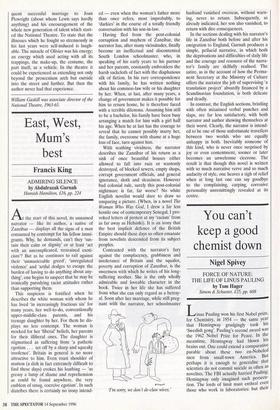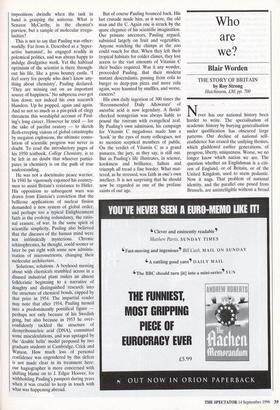You can't keep a good chemist down
Nigel Spivey
FORCE OF NATURE: THE LIFE OF LINUS PAULING by Tom Hager
Simon & Schuster, £25, pp. 608
Linus Pauling won his first Nobel prize, for Chemistry, in 1954 — the same year that Hemingway grudgingly took his 'Swedish gong'. Pauling's second award was the 1962 Nobel Prize for Peace. In the meantime, Hemingway had blown his brains out. One could extend a comparative parable about these two en-Nobeled men from small-town America. But perhaps it is enough to generalise that scientists do not commit suicide as often as novelists. The FBI actually harried Pauling; Hemingway only imagined such persecu- tion. The lords of limit must enthral even those who work in laboratories: but their
impositions dwindle when the task in hand is grasping the universe. What is Senator McCarthy, in the chemist's purview, but a sample of molecular irregu- larities?
This is not to say that Pauling was other- worldly. Far from it. Described as a 'hyper- active humanist', he engaged readily in polemical politics, and was always happy to indulge divulgative work. Yet the habitual optimism of the scientist is there through- out his life, like a gross bouncy castle. 'I feel sixty for people who don't know any- thing about chemistry', Pauling declared. `They are missing out on an important source of happiness.' No subpoena ever got him down; nor indeed his own research blunders, Up he popped, again and again. And so not so much as a pin-prick of elegy threatens this worshipful account of Paul- ing's long career. However he tried — for the sake of pacifist oratory — to sketch flesh-creeping visions of global catastrophe by megaton explosions, the ultimate conso- lation of scientific progress was never in doubt. To read the introductory pages of his 1950 textbook, College Chemistry, is to be left in no doubt that whoever partici- pates in chemistry is on the path of true understanding.
He was not a doctrinaire peace warrior. In 1940 he vigorously enjoined his country- men to assist Britain's resistance to Hitler. His opposition to subsequent wars was drawn from Einstein's conviction that the bellicose applications of nuclear fission demanded a new system of global order; and perhaps too a typical Enlightenment faith in the evolving redundancy, the ratio- nal erasure, of war. In the same spirit of scientific simplicity, Pauling also believed that the diseases of the human mind were not intrinsically mysterious. Chronic schizophrenics, he thought, could sooner or later be put right with some new adminis- tration of micronutrients, changing their molecular architecture.
Solutions, solutions. A boyhood messing about with chemicals stumbled across in a disused industrial plant makes an almost folkloristic beginning to a narrative of doughty and distinguished research into the structure of chemical bonds, capped by that prize in 1954. The impartial reader may note that after 1954, Pauling turned into a predominantly pontifical figure perhaps not only because of his Swedish gong, but also because in 1953 he over- confidently tackled the structure of deoxyribonucleic acid (DNA), committed some miscalculations, and was upstaged by the 'double helix' model proposed by two graduate students at Cambridge, Crick and Watson. How much loss of personal confidence was engendered by this defeat is not made clear in its treatment here: our hagiographer is more concerned with shifting blame on to J. Edgar Hoover, for withholding Pauling's passport during years when it was crucial to keep in touch with what was happening abroad. But of course Pauling bounced back. His last crusade made him, as it were, the old man and the C. Again one is struck by the spare elegance of his scientific imagination. Our primate ancestors, Pauling argued, subsisted largely on fruit and vegetables. Anyone watching the chimps at the zoo could vouch for that. When they left their tropical habitats for colder climes, they lost access to the vast amounts of Vitamin C their bodies required. Was it any wonder, proceeded Pauling, that their modern mutant descendants, passing from cola to burger to deep-pan pizza and more cola again, were haunted by snuffles, and worse, cancers?
His own daily ingestion of 300 times the 'Recommended Daily Allowance' of ascorbic acid is now legendary. A florid- checked nonagerian was always liable to pound the rostrum with evangelical zeal. By Pauling's own admission, his campaign for Vitamin C megadoses made him a 'kook' in the eyes of many colleagues, not to mention sceptical members of public. On the verdict of Vitamin C as a grand panacea, the jury, as they say, is still out. But as Pauling's life illustrates, in science, kookiness and brilliance, failure and triumph all tread a fine border. What mat- tered, as he stressed, was faith in one's own intellect. It is not surprising that he should now be regarded as one of the profane saints of our age.



































































 Previous page
Previous page